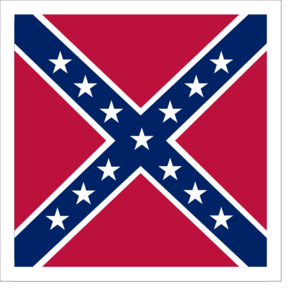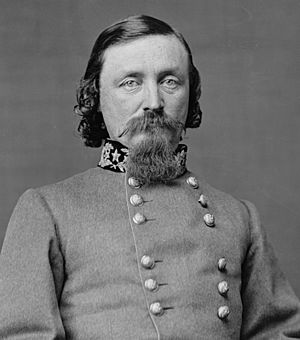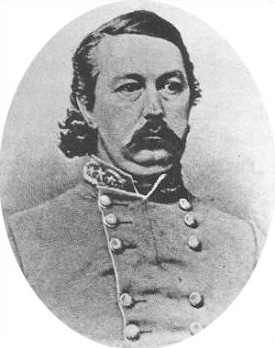First Corps, Army of Northern Virginia facts for kids
Quick facts for kids First Corps,Army of Northern Virginia |
|
|---|---|

Battle flag of the Army of Northern Virginia
|
|
| Active | December 1862 – April 10, 1865 |
| Country | |
| Branch | |
| Type | Corps |
| Role | Infantry |
| Size | 2-5 divisions |
| Part of | Army of Northern Virginia Army of Tennessee |
| Engagements | American Civil War |
| Commanders | |
| Notable commanders |
James Longstreet John Bell Hood Richard H. Anderson |
The First Corps, Army of Northern Virginia (also known as Longstreet's Corps) was a military group that fought for the Confederate States of America during the American Civil War. It was created in early 1861 and served until spring 1865. Most of its service was in the Eastern part of the war. James Longstreet led the corps for most of its time.
This corps, or parts of it, fought in almost all the big battles in the Eastern Theater. These battles included Fredericksburg, Gettysburg, The Wilderness, Cold Harbor, and the Siege of Petersburg. The corps also fought in Tennessee. It was officially ended shortly after General Robert E. Lee surrendered to Union forces on April 9, 1865.
Contents
How the First Corps Started

On June 1, 1862, Robert E. Lee took command of the Confederate Army of the Potomac. This happened after General Johnston was hurt during the Battle of Seven Pines. Soon after, this army became known as the Army of Northern Virginia.
Lee reorganized the army into two main "wings." Corps were not officially allowed by the Confederate government until September 1862. Lt. Gen. James Longstreet was put in charge of the Right Wing. Lt. Gen. Thomas J. "Stonewall" Jackson led the Left Wing. When corps were officially formed later that year, Longstreet's Right Wing became the First Corps. At this time, Longstreet's corps had five divisions. These divisions were led by major generals Lafayette McLaws, Richard H. Anderson, George E. Pickett, and John B. Hood, and Brigadier General Robert Ransom, Jr..
Battles in 1862
Fredericksburg Battle
The Battle of Fredericksburg took place in and around Fredericksburg, Virginia. It started on December 11 and ended on December 15, 1862. Lee's Army of Northern Virginia fought against the Federal Army of the Potomac. Maj. Gen. Ambrose E. Burnside now commanded the Union army.
The First Corps began arriving at Marye's Heights on November 18. They set up their positions there to stop the Union army from crossing the river using pontoon bridges. The Second Corps arrived quickly once Lee was sure of Burnside's plans. The First Corps did not dig deep trenches until a few weeks before the main fighting on December 12. After Jackson arrived on December 2, Longstreet started digging trenches along his part of the line. Anderson's division was near Banks Ford on the Rappahannock River. The other divisions were on Marye's Heights. Artillery was placed along the top of the ridge by Lieutenant Colonel E. Porter Alexander.
On December 11, Union soldiers began building bridges across the Rappahannock at Fredericksburg. William Barksdale's brigade, spread along the city's riverfront, fought them. The Confederates started shooting at the Union bridge builders early that morning, forcing them to stop. Union artillery fired from Strafford Heights but could not make Barksdale's brigade leave their spots. Around 3 p.m., small groups of Union soldiers crossed the river and pushed the Confederates through the city. Barksdale's men pulled back to the main Confederate lines after 7 p.m.
In January 1863, Ransom's division was moved to North Carolina.
Battles in 1863
Suffolk and Chancellorsville
Longstreet and part of the First Corps (Hood's and Pickett's divisions) were sent away from the Army of Northern Virginia on February 26. They went to Suffolk, Virginia. Their job was to deal with Union forces there from the IX Corps. They also helped Confederate authorities collect supplies in the area. For several months, Longstreet was in charge of the Department of Southern Virginia and North Carolina.
Starting on April 11, Longstreet used his two divisions to lay siege to Suffolk. This helped them gather more supplies nearby. After three weeks, he was told to stop the siege and return to Lee's main army. However, the Battle of Chancellorsville ended before Longstreet arrived.
Gettysburg Battle
After Jackson died in May, the Army of Northern Virginia was reorganized into three corps. Longstreet kept McLaws', Hood's, and Pickett's divisions. Richard Anderson's division was moved to the new Third Corps, led by A.P. Hill. Two of Pickett's brigades were sent to help Confederate forces in North Carolina and near Richmond. This left only three brigades in his division.
By late June 1863, the Army of Northern Virginia had moved through the Shenandoah Valley. They crossed Maryland and entered Pennsylvania. They used the Blue Ridge Mountains to hide their movements from Union cavalry patrols. The First Corps started crossing the Potomac River into Maryland on June 25 and finished the next day. The corps then camped for several days near Chambersburg, Pennsylvania.
Hood's and McLaws' divisions of the First Corps were far from Cashtown. They did not arrive in time to fight on the first day of the battle, July 1. Pickett's division was even farther back, guarding communication lines through Chambersburg. It did not rejoin the army until late on July 2. On the first day, units from the Second and Third Corps pushed Union I and XI Corps back through Gettysburg.
Late on the second day of the battle, the two present divisions of the First Corps attacked the Union left side. Hood's division, on the southern right, took Devil's Den from Sickles' III Corps. They also moved onto Big Round Top, but could not get around the Union flank. His tired troops were stopped by Col. Strong Vincent's brigade on Little Round Top. Hood himself was wounded and lost an arm. McLaws' division attacked an hour after Hood started. They fought against the Union III and V Corps, with help from parts of the Union II Corps. McLaws' division suffered heavy losses in the Wheatfield and the Peach Orchard without making much progress.
On the third day, Pickett's division, which had finally arrived, and two smaller divisions from the Third Corps attacked the middle of the Union lines near Cemetery Ridge. Longstreet was in command of this attack. He thought it would fail and protested, but he was ordered to go ahead. After a very large artillery barrage, a column of about 11,000 to 15,000 men advanced. They marched nearly a mile across open ground, facing heavy artillery and musket fire. The attack was a big failure. Pickett's division lost over 2,600 men, all three brigade commanders, and almost all regimental commanders. Even though Pickett's division was only one part of the attack, the whole event is usually called Pickett's Charge. The army then retreated back to Virginia, arriving 10 days later after a difficult journey.
Chickamauga Battle

On September 9, the First Corps was moved to the Department of Tennessee. Pickett's division and the brigade of "Tige" Anderson stayed behind. The main goal for both armies in the West was the rail hub at Chattanooga. The Union Army of the Cumberland had nearly 60,000 men. The Confederate Army of Tennessee led by Gen. Braxton Bragg, along with the First Corps and other help, would have over 65,000 troops.
To reach and help Bragg's army, the First Corps used 16 railroads. They traveled nearly 800 miles (1,350 km) through North and South Carolina to reach the Army of Tennessee in northern Georgia. This long, indirect route was needed because the different parts of the Southern rail system had different track widths. The journey took three weeks.
The first parts of Longstreet's corps, three brigades from Maj. Gen. John Bell Hood's division, joined with a western division. They started the battle on September 18 by crossing Chickamauga Creek at Reed's Bridge. Since Longstreet had not yet arrived, Hood took command of the corps. Brig. Gen. Evander Law took command of Hood's division. The First Corps fought in the same formation the next day on the Confederate left. On September 20, Longstreet arrived with two brigades from McLaws's division. Since McLaws had not arrived, Brig. Gen. Joseph B. Kershaw led these brigades.
Bragg used Longstreet's arrival to reorganize his army into wings. Longstreet commanded the left wing. This wing included his own corps (under Hood), Buckner's corps, and Hindman's division. Leonidas Polk commanded the right wing. The First Corps played a key role in the breakthrough Longstreet achieved on September 20. This battle is seen as the most important Union defeat in the Western Theater. More than 34,000 soldiers from both sides were killed, wounded, or captured.
Knoxville Campaign
- November 4: Longstreet leaves Chattanooga.
- November 6: Battle of Big Creek, Rogersville. The Army of West Virginia attacks to support Longstreet.
- November 15: Engagement at Ft. Dickerson.
- November 16: Battle of Campbell's Station.
- November 17: Longstreet begins to besiege Knoxville.
- November 18: Engagement at West Knoxville. Union General Sanders is badly wounded and dies.
- November 25: Engagement at Armstrong's Hill, South Knoxville.
- November 28: It is rainy and cold in Knoxville. General McLaws pushes back the guards at Fort Sanders that evening. An alarm sounds in Fort Sanders at 11:00 p.m., but the expected attack does not happen. The fort's defenders sleep with their guns in the mud under small tents.
- November 29: Attack on Fort Loudon / Sanders. At sunrise, Union troops in Ft. Loudon raise a large US flag on a new flagpole. The band plays Reveille and the National Anthem. Confederate artillery bombs the fort. Then, the Confederate infantry charges, but it ends in disaster in 15 minutes. A truce is called to carry away the dead, wounded, and prisoners.
Winter 1863–64
About an hour after the failed attack on Fort Sanders on November 29, a telegram arrived from President Jefferson Davis. It told Longstreet about Bragg's defeat at Chattanooga. It also ordered the First Corps to rejoin the Army of Tennessee. At first, Longstreet decided to leave Knoxville right away. He ordered the wagon train to move back at once. Then, two messages from Bragg arrived. They suggested the First Corps should cross the mountains into Georgia to reach the retreating army.
Longstreet held meetings with his senior officers. They realized how hard it would be to cross the mountains. So, they decided to stay at Knoxville until Union reinforcements arrived. Then, they would go into winter camps near Bristol, Virginia.
On December 1, Confederate cavalry patrols captured an enemy messenger. The message for Burnside said three columns had been sent to help him. Longstreet acted on this information, which later turned out to be a trick. He ordered his wagons to start moving eastward with guards. The 15,000 infantrymen began to follow late on December 4. They marched all night in heavy rain. Over the next four days, the First Corps retreated toward Virginia. They passed through Bean's Station and headed for Rogersville in Hawkins County, Tennessee. Longstreet stopped there on December 9. The next day, he received permission from Davis to command all soldiers in his region. With this, he called back the cavalry units that had been sent to Bragg in Georgia. Longstreet rested his command at Rogersville until December 13. Then, he learned that Union infantry and cavalry were chasing them back at Bean's Station. He decided to turn and attack them the next day.
Battle of Bean's Station
- Battle of Bean's Station - December 14, 1863
- Battle of Mossy Creek - December 29, 1863
Civil War Service in 1864
- Battle of Dandridge, Tn. - January 17, 1864
- Battle of Fair Garden, Tn. - January 27, 1864
Overland Campaign
At the start of the Overland Campaign, the First Corps was 25 miles (40 km) away. They were guarding rail lines at Gordonsville. The rest of Lee's army fought Meade's Army of the Potomac in the Battle of the Wilderness on May 5. Longstreet received orders to rejoin the army and help A.P. Hill's Third Corps before 4 a.m. on May 4.
By midday on May 6, the Third Corps was in danger of being overwhelmed by the Union II Corps. Then, the First Corps arrived and filled the gap created by the fighting. Longstreet sent his men directly against the tired Union II Corps. They regained almost all the ground lost so far in the battle. Then, they pushed the II Corps another mile (1.6 km).
Soon after making the Confederate line stable, a Confederate engineer found an unfinished railroad bed. This gave the Confederates a way to get to the Union's left side. Longstreet put together a flanking force. It had four brigades from his own First Corps and from the Third Corps. The first attack was successful in routing the Union flank. However, the Confederates quickly got confused in the thick woods. At this time, Longstreet was seriously wounded in his neck by friendly fire. Command of the First Corps temporarily went to Maj. Gen. Charles W. Field. He then reorganized the corps into a defensive line. On May 7, Lee decided to replace Field with Richard Anderson.
The Battle of Spotsylvania Court House was fought from May 8 to May 21. It took place along a four-mile trench line in and around Spotsylvania. This was about 10 miles southeast of the Wilderness battlefields.
On the evening of May 7, Lee ordered Maj. Gen. Richard Anderson to move his corps to Spotsylvania Court House. Lee believed that Grant was heading to the same place. He told Anderson to have his men moving by three in the morning. But Anderson decided to move at ten that evening. This decision proved to help the Army of Northern Virginia a lot. At the same time Lee sent Anderson, Grant decided to move his army to the same spot. Grant hoped to make Lee come out into the open and get between Lee and Richmond.
The First Corps had just arrived at Block House Bridge. Anderson was told that Maj. Gen. J.E.B. Stuart was holding off Grant's infantry (parts of Warren's V Corps) on Brock Road. Stuart needed help. Anderson sent the brigades of Henegan and Humphreys to help. When they arrived, Stuart placed them along the top of Laurel Hill. They successfully held off the Union advance. Soon after Anderson sent his first two brigades, a messenger from Maj. Gen. Fitzhugh Lee arrived. Fitzhugh Lee was fighting Union cavalry units of Brig. Gen. James H. Wilson, who had just broken through to the Court House. Anderson immediately sent the brigades of Bryan and Wofford. They helped Lee fight off the cavalrymen.
The First Corps spent most of the battle defending against repeated attacks on Laurel Hill. Both V Corps infantry and units from Hancock's II Corps attacked. The First Corps was not heavily involved in the fighting in and around the "Bloody Angle."
Civil War Service in 1865
Five Forks and Appomattox
After Lt. Gen. A.P. Hill died at Petersburg, the remaining parts of the Third Corps were combined into the First Corps on April 2.
Surrender and Parole




